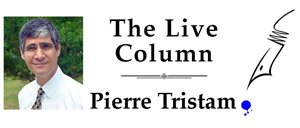
Alfred Leo Smith was a recovering alcoholic who worked as a counselor at a private Oregon clinic for recovering addicts. When a Native American colleague was fired for using peyote, the mescalin drug common in certain Indian ceremonies, he intentionally smoked it too and was fired. Both men were denied unemployment benefits. They sued the state, claiming their First Amendment rights were violated.
Six years later–in 1990–the U.S. Supreme Court ruled against them. Oregon was free to legalize an exemption for peyote, but there was no such exemption in state law, and the First Amendment did not require it, the court ruled.
“We have never held that an individual’s religious beliefs excuse him from compliance with an otherwise valid law prohibiting conduct that the State is free to regulate,” Justice Antonin Scalia wrote in his majority opinion. The court in 1878 had ruled against Mormons–the Church of Jesus Christ of Latter-day Saints, as it prefers to be called–using the First Amendment to shield their bigamy, thus outlawing Mormons’ (or anyone’s) polygamy.[1] No court will sanction female genital mutilation, one of North Africa and the Middle East’s more barbaric practices hiding behind religious custom, or the segregation of women during their period, as is still common in parts of Nepal or Brooklyn’s Williamsburg. No licensed professional could or should get away with recommending such harmful practices.
In Oregon the state wasn’t targeting peyote, which would have been illegal. It was targeting illegal drugs, which peyote was (though Oregon was not prosecuting anyone for its use).
Scalia said lawmakers were free to make exceptions. But the First Amendment could not be interpreted to mean that “each conscience is a law unto itself.” He predicted that it might result in preferential treatment for more conventional religions at the expense of “practices that are not widely engaged in.”[2] But “that unavoidable consequence of democratic government must be preferred to a system in which each conscience is a law unto itself.”
Three years later Newt Gingrich’s Congress passed the Religious Freedom Restoration Act in response. It translated the zealotry of a Great Awakening to law, severely breaching the church-state wall. The law completed the demolition Scalia had started by doing away with a higher standard of review–the so-called “strict scrutiny” test–when it came to religious preferences or disfavor.[3]
The Religious Freedom and Restoration Act turned the First Amendment on its head. An amendment intended to protect secularism in public spaces and prevent religious discrimination in private ones has been reinterpreted to promote religious expressions in public schools, at government meetings and in public squares while indemnifying private companies’ bigotry as long as they invoke their religious freedom.
Those inclined to destroy the separation of church and state like to say that freedom of religion does not mean freedom from religion. But the two are not mutually exclusive, and that’s exactly how the First Amendment was intended: granting freedom to individuals or collectives to practice any religion they please without government interference, but also without interfering with others’ practice or non-practice of their own religion. Christians don’t like that second part, as it means leaving public spheres free of religious expression that might infringe on an individual’s wish to be let alone.[4] That means freedom from religion in public spaces and public policy, including in government regulations.
We’ve gone sharply and zealously in the other direction. Scalia[5] feared a system “in which each conscience is a law unto itself.” It’s exactly the system he invited with the Oregon decision.[6]
We saw it in the Hobby Lobby decision that allowed the company to deny birth control coverage to its women employees, because it considers it un-Christian.[7] We saw it in the decision the same year that now allows public meetings to start with a prayer even when, as is always the case, privileging Christianity.[8] We saw it last year in the right granted homophobic or racist parents to opt out of class time if they don’t like certain books. We saw it in the decision allowing businesses not to serve gays, if it means so much as transcribing a loving six-word message by one gay person to another on a damn cake. We will see it soon in the funding of religious charter schools at public expense.
And we will see it by June when the court rules, probably 6-3, that states may not ban licensed counselors from preaching conversion therapy to patients under 18.
Conversion therapy is the non-medical and debunked theory that if you hector gays, lesbians, trans and enbys long enough, they’ll convert back to heterosexuality. Put in an equally crude way, it’s like telling a Black or Asian person that if they try hard enough, they could be white. The approach is premised on self-loathing. It’s abusive. It has nothing to do with science. It has everything to do with a perverted interpretation of Christianity’s vilification of anything non-heterodox.[9] Imagine if the old practice of bleeding was revived and termed a First Amendment right since bleeding was thought to flush demons from the body. That’s what this conversion therapy case is about.[10]
Many states ban conversion therapy for minors.[11] No state disallows churches or youtubers and other nitwits from preaching it on their Facebook pages. The ban only applies to licensed medical professionals, just as it would with any other nonsensical medical practice. That’s the difference the Supreme Court is about to demolish, erasing the line between professional licensing and theology, between science and snake oil.
You expect this from Iran’s Supreme Council of Islamic mullahs. You don’t expect it from Justices steeped in science and 230 years of First Amendment law. But we’re no longer that society, and this is no longer a secular court but the vanguard of a theocracy where each conscience is a law unto itself. Let us bow to quackery.
![]()
Pierre Tristam is the editor of FlaglerLive. A version of this piece airs on WNZF.
![]()
Notes and Amplifications:
[Keeping in mind that these notes and amplifications are not essential to the commentary nor recommended reading, at least not without a beer or two. They are pedantry’s sandbox. Abandon all hope ye who enter here.]
[1] There’s nothing wrong with polygamy. It’s easy, if not logical (and more easily demonstrable), to argue that monogamy, like monotheism, is against nature. The more the merrier, whether gods or spouses. The less absurd and oppressive and intolerable, too. The problem with polygamy isn’t the principle but, as always when religion corrupts a good thing, as religion always does, its application. For Mormons as for Muslims (the two cults share more DNA than not), the practice was strictly one way: a man could have several wives (up to four in Islam, unlimited plans in the Church of Latter Day Saints, until the church officially banned the practice in 1890), a woman could only have one spouse. Obviously in neither cult could a Sappho or Abu Nuwas (a Whitmanesque Muslim of the 9th century) thrive. It’s those prohibitions that justly lend revulsion to polygamy, not polygamy in itself. In any case, prohibitions have done nothing to stop it. As Updike’s Couples documented with erogenous granularity, we nowadays redefine polygamy as adultery if a marriage contract is involved. Without the contract, we’re all, or have all been at one time or another (and not just since the sexual revolution), polygamists in hock to Fanny Hill.
[2] Is there anything weirder than the subjectivity of judgments about one religion’s validity over another, of the subjectivity that deems, say, the Catholic Church more legitimate than Heave’s Gate, the Branch Davidians or Jim Jones’s People’s Church, none of which–if body counts are to count for anything–on their worst day (they each had horrific ones) approach the bloodletting in the Catholic Church’s name on any one of the 550,000 days of its reign before the Enlightenment and secularism slowed its genocidal orgies, which continue to this day?
[3] In English: strict scrutiny is the strongest constitutional test of a law’s validity. If the state can’t convincingly show that the law is in the public interest, it’s invalid. It’s a good standard to apply to First Amendment cases, whether about religion or free speech. Justice Sandra Day O’Connor in her partial concurrence and partial dissent had argued that applying strict scrutiny in the Oregon case would have yielded the same result Scalia was seeking. She thought he went too far by discarding strict scrutiny, perhaps seeing what was ahead. So Scalia’s decision was both visionary and short-sighted–visionary for refusing to go along with a standard that makes every person a religion unto itself and short-sighted for not seeing that inviting–or daring–Congress and legislatures to write laws elevating religion beyond First Amendment protections wouldn’t have the floodgate effect of Christianizing the country, as it has. Then again, the wily Scalia was no fool, and may have known exactly what he was doing by merely appearing to open the gates of Ijtihad, when he was very much closing them in Christianity’s favor. What Scalia did in the 1990 case, Justice Neil Gorsuch, Samuel Alito and Clarence Thomas are itching to do to libel law, invalidating Sullivan v. New York Times, the 1964 decision that not only found that to prove libel in a case involving a public official, the plaintiff had to prove that falsehoods were published with malice and reckless disregard for the truth, but that trial courts had to apply a strict scrutiny test to any claim of libel, thus raising an extra protective shield for the press. It has freed the press from endless threats of lawsuits and self-censorship. It has also led to rampant abuses from unscrupulous journalists and fake-news organizations like Fox and its viral progenies, though not without occasional cost.
[4] I’ve never understood how the very same people who would be indignant at any sexual or erotic expression in a public space feel perfectly comfortable to the point of presumption to express religious feelings in those spaces. I see no difference between the two. We are entitled to both. Religion, like sex, is an essential part of us. But religion, like sex, belongs exclusively to our private world–houses of worship, houses of pleasure, our own houses and wherever else our private world extends. Just not in public. Religious expression openly expressed by strangers around me repels me, and I suspect the revulsion is no different than how those pious eminences might react if I were to speak to them of my favorite sexual positions. Why should they not extend me the same discretion when it comes to their religious expression?
[5] Scalia was not fond of the 1960s Warren Court. Reagan appointed him to smash a lot of those precedents. He did, spending the first half of his tenure, before his straitjacket came off as the court veered decisively right, planting delay-action legal bombs like the Oregon decision.
[6] As Americans bred on a mythology of cultural and racial superiority (“America First,” “the American Dream,” “only in America”), we like to think of ourselves, in our brawny gallery of best, strongest, freest, as the country with the most respectful religious rights. We do well in that department. Certainly better than most. But we’re nowhere near “best.” According to the Pew Resarch Center’s annual tracking of religious restrictions around the world, at least three dozen countries have fewer restrictions, whether imposed by government or by social hostilities. (When’s the last time you didn’t sneer when you saw a Muslim take a few moments to pray in a discreet corner of a public venue, as you never would sneer when the table next-over joins hands to say Grace?)
[7] It is no different than–if Hobby Lobby were owned by a Saudi Wahhabi prince, say–forcing women to wear a burqa at work and calling it the company’s freedom to express its religious beliefs on its own turf.
[8] Those abuses are notorious in Flagler County, specifically in Bunnell, where, when the likes of City Commissioners John Rogers or the police chief open commission meetings with prayer, the words “Christ,” “Jesus” and “god” outnumber all others. Town of Greece v. Galloway, the 2014 decision of a split 5-4 court, “acknowledges our growing diversity not by proscribing sectarian content but by welcoming ministers of many creeds,” in Justice Anthony Kennedy’s words for the majority, but does not require the prayer to be non-sectarian, or non-specifically Christian, as that “would force the legislatures that sponsor prayers and the courts that are asked to decide these cases to act as supervisors and censors of religious speech, a rule that would involve government in religious matters to a far greater degree than is the case under the town’s current practice of neither editing or approving prayers in advance nor criticizing their content after the fact.” Kennedy minimized the intention of prayer as merely bringing gravity to the proceedings at the beginning of meetings. He punted when faced with the slippery-slope inappropriateness of prayers that turn preachy: “If the course and practice over time shows that the invocations denigrate nonbelievers or religious minorities, threaten damnation, or preach conversion, many present may consider the prayer to fall short of the desire to elevate the purpose of the occasion and to unite lawmakers in their common effort. That circumstance would present a different case than the one presently before the Court.” But the circumstance is implicitly always in play, the moment a denominational prayer is spoken. Unitarians and rare other ecumenical sects aside, no religion’s prayer ever markets approvingly to iconoclasts and heretics. Kennedy also left unclear whether it is permissible for elected officials to say the prayers, though his context strongly suggests it is not permissible, just as it has never been so, as it would then place the elected in a position of explicitly endorsing–of preaching–the prayer: it doesn’t get more Establishment than that. Kennedy remarks on the “several occasions where audience members were asked to rise for the prayer. These requests, however, came not from town leaders but from the guest ministers, who presumably are accustomed to directing their congregations in this way and might have done so thinking the action was inclusive, not coercive.” The fact that the “guest ministers” are specified underscores the still-prevailing rule thgat the elected must not deliver the prayer, let alone direct congregants to stand or sit in response, or ask them to bow their heads, as they routinely do in Bunnell.
[9] The self-loathing takes its source from the despicable and entirely un-Christ-like admonition we find in Matthew 5:29, “And if thy right eye offend thee, pluck it out, and cast it from thee: for it is profitable for thee that one of thy members should perish, and not that thy whole body should be cast into hell,” an admonition to which John’s Christ dissented (“He that is without sin among you, let him first cast a stone,” and so on.) Origen, unfortunately, stopped at Matthew, as did Augustine, who codified self-loathing of the human body for 1500 years of church doctrine and to this day scripts the moral mutilation of conversion therapy.
[10] Kaley Chiles is a licensed Colorado counselor who runs a place called “Deeper Stories Counseling” and tells her patients that “Creating a relationship with a therapist is a playground, an experiment, for learning which then fosters blossoming new relationships with self and with others (including God).” Her parentheses. More power to her. She sounds like a lovely person. So lovely and inoffensive that Colorado has made clear it has no intention of prosecuting her. She obviously has a very light hand. The state is not intending to stop therapists from including a religious point of view in the mix, and that’s not the sort of aberrant, shame-ridden “therapy” it had in mind when it passed the sort of law 25 other states have on their books–a law intended to keep charlatans from using their license as a shield for harmful, often deadly therapy. So the case should not even have been considered since, as Justice Sotomayor said in oral arguments and Scotus Blog reported, “there was no ‘credible threat of prosecution,’ as the Supreme Court’s cases require for a party to have standing.” But the Alliance Defending Freedom (formerly Alliance Defense Fund), wanted a case. It chose this one, since it would allow for a much wider door to open for conversion therapy. That ADF (not to be confused with the Anti-Defamation League) is the hard-right James Dobson progeny that tried to destroy the Affordable Care Act and succeeded in some regards. The Hobby Lobby decision and the ruling letting businesses refuse service to gays are its cap’s toxiest feathers. It now wants to forbid women from receiving abortion pills by mail, forbid transgender girls from participation in boys’ sports, and of course forbid states from regulating medical practitioners’ baseless and harmful claims. You can “sign up to pray for freedom’s future” on its website. So here we are.
[11] As you might expect, Free Florida, land of DeSantis, Ladapo and parental might, goes the other way, forbidding local governments from banning conversion therapy.





























Deborah Coffey says
All the quacks will say that you are persecuting them for their religious beliefs, Pierre. But, in my thinking, laws should be made and judged on whether or not “something” harms children/people and should be considered with a full amount of evidence. Look at guns in America. School after school gets shot up killing children and teachers and all those over 300,000,000 guns floating around America are just fine with the Supreme Court. Instead of laws, we get “thoughts and prayers.” Total quackery.
If we believe AI, evidence is abundant in the practice of conversation therapy:
AI Overview
Conversion therapy is widely condemned by major medical and mental health organizations as ineffective and extremely harmful, inflicting severe psychological and physical damage on LGBTQ+ individuals. Research shows it fails to change a person’s sexual orientation or gender identity and reinforces harmful societal prejudice.
Psychological harm
The psychological harm from conversion therapy is well-documented and pervasive, leading to severe and long-lasting distress.
Depression and anxiety:
Participants are at a significantly higher risk for experiencing mental health crises, including severe depression, anxiety, and post-traumatic stress disorder (PTSD). A 2024 study by Stanford Medicine found that people who underwent conversion practices for gender identity experienced more symptoms of depression.
Increased suicide risk:
Studies show a strong link between conversion therapy and a higher risk of suicide. LGBTQ+ youth who have undergone the practice are more than twice as likely to attempt suicide and 2.5 times as likely to make multiple attempts. Even among adults, exposure to conversion therapy is associated with increased odds of suicidal thoughts and attempts.
Internalized homophobia and self-hatred:
By framing being gay or transgender as a problem to be fixed, conversion therapy reinforces harmful societal stigma. This can cause individuals to internalize these prejudices, leading to intense shame, guilt, and a deep sense of self-hatred.
Loss of self-esteem:
The invalidating and shaming nature of the practice can undermine a person’s self-concept, eroding their self-esteem and sense of worth.
Family rejection and isolation:
For many, conversion therapy is a form of family rejection. It can create deep rifts between LGBTQ+ youth and their families, leading to social isolation and cutting off a crucial source of support.
Physical harm
In addition to psychological damage, some forms of conversion therapy involve dangerous physical tactics that can cause serious bodily harm.
Aversion therapy:
Historically, and in some cases today, conversion practices have included aversion techniques designed to create a negative association with same-sex attraction. These methods have included inducing vomiting with drugs or administering electric shocks.
Abusive practices:
As reported by a UN expert, some victims of conversion therapy have been subjected to beatings, shackling, food deprivation, and even exorcisms.
Long-term and societal consequences
The harm from conversion therapy extends beyond the immediate experience, with negative effects lasting long into adulthood.
Compromised well-being: A study on older gay and bisexual men found that those who had undergone conversion therapy were more likely to have depressive symptoms and internalized homophobia, indicating a long-term impact on psychosocial health.
Economic burden:
In addition to the immense human toll, the associated harms of conversion therapy—including increased healthcare costs for substance abuse and mental health conditions—are estimated to cost the U.S. economy billions of dollars annually.
Reinforcement of discrimination:
By operating on the false premise that LGBTQ+ identities are disordered, conversion practices perpetuate prejudice and discrimination against LGBTQ+ people in society.
Pogo says
@Or
…maybe it’s just what it seems to me: a bunch of muggers who start by telling you your zipper is open, so they can sucker punch you — and take everything you have. Everything.
The victims, everyone, complain their zipper was closed, they don’t have a zipper, etc., and the muggers pretend to find themselves.
Oh, well.
Skibum says
A person’s sexual orientation is NOT a choice, and I completely agree that the myth of conversion therapy is not only worthless, it is dangerous.
I didn’t “decide” one day to be gay… it was long, long ago pre-determined for me. All I have to do is ask any heterosexual to tell me when exactly that person understood they could either be gay or straight because both were acceptable to them personally, and when that was that they made a conscious CHOICE to be straight. The answer, of course, is they DIDN’T make a conscious choice because they were already heterosexual.
It is no different for those who are gay, or those who find themselves attracted to both sexes, maybe somewhere in-between. Sexuality is so complex that it is not something that can be turned on and off at will, or simply “prayed away” by ridiculous religion based conversion therapy.
Too many Christians want to believe gay people can or need to be healed. Well, I do not need any “healing”, just as it would be ridiculous (and impossible) for me to tell one of them that I will “heal” them through prayer and quack “therapy” to turn them gay!
I don’t know why so many of them seem to be incapable of grasping logic and common sense. It would be so much better for everyone if they concentrated on improving their own lives instead of trying to change other people into their own images.
Bob says
The smell of men repulses me. It’s an anti-aphrodisiac. So does my olfactory/neurological response make me viruous? It’s not something I chose; it’s like my eye color; such variations are no more inherently moral than that, otherwise we’d need to ship all these pseudo therapists to sheep farms.
This is by AI, but not being an ignorant, city-folk-type, I knew this from simple observation: (I had asked about a specific breed in which I had observed this behavior.)
————————————————————————————————————————
Homosexual behavior in males is well-documented across all domestic sheep (Ovis aries) populations, rather than being specific to a single breed. An estimated 8% to 10% of all domestic rams (male sheep) exhibit an exclusive sexual preference for other males, even when fertile ewes (female sheep) are available.
This phenomenon has been extensively studied in domestic sheep populations, particularly those common to the western United States, as a biological model for understanding sexual orientation. Key findings from research include:
Prevalence: The percentage of exclusively male-oriented rams is consistent across populations of domestic sheep.
Behavior: The male-oriented rams display the same courtship behaviors toward other males (foreleg kicks, anogenital sniffs, mounting, and ejaculation) as female-oriented rams do toward ewes.
Biological Basis Studies have found that male-oriented rams have a smaller sexually dimorphic nucleus of the preoptic area (oSDN) in their hypothalamus compared to female-oriented rams; the size of this brain region is comparable to that of ewes.
Fetal Development: The difference in brain structure is believed to be organized during prenatal development by hormone exposure, suggesting a biological, not social, basis for the sexual preference.
A German farmer, Michael Stücke, has established a sanctuary for these non-breeding rams, creating a project called Rainbow Wool to use their wool for knitwear, with proceeds supporting LGBTQ+ charities.
Skibum says
Maybe the homophobes who read this will stop eating lambchops, thinking with their warped brains that consuming lamb would turn them gay. Ignorance prevails.
Pig Farmer says
I simply cannot understand why these people are so fixated on what other people do in the privacy of their own bedrooms. If you don’t like gay sex, then don’t have gay sex. As long as both parties are adults and consent, nobody should care.
Bob says
I’ve read that Bigotry is the fear that somewhere someone you look down on is being treated as well as you are. I doubt your rational admonitions will help these people be less cruel. They seem driven either by a hairy dispeptic god or the emotional resentments of the insecure.
Laurel says
Skibum: Because conformity is a comfort zone for some. Like Linus’s security blanket. They have little interest in discovering a person’s soul.
Yeah, I figured it out when I realized that women can be beautiful and can be sexy, and I can admire a woman, but I could never fall in love with one, no matter what! With Brad Pitt and Bradley Cooper around (and of course, hubby), I’m good to go! :D So, that was clear to me. What really consolidated it for me, was, I was in a beach park one evening, and saw two old ladies, walking hand in hand, up the boardwalk. I didn’t know if they were gay, sisters, or just friends, and I thought “love is love, and that’s what’s important.” That’s all.
Deborah Coffey says
@ Skibum
Your comment is perfect. Could the problem be that some “fake” Christians don’t believe in science? They obviously don’t know that God IS Science, as he is all things at once and all-knowing. Furthermore, He created gay animals. There’s been tons of study and lots of proof over time that many animals are gay. I don’t know God’s reasoning for this but, it seems to be a huge test of love and acceptance for many of “His people.” What needs to be made clear to the haters and the wannabe healers is the one thing we know for sure; God didn’t create haters. We are born out of love and it is His desire that we grow in love as we do our work here on Earth. Thanks again. I really like what you’ve written here. Truth always gives me joy and we have too little of it these days.
Skibum says
Thank you, Laurel and Deborah for your comments of support. It means a lot to me.
Isn”t it so ridiculous that with all of the DIVERSITY around us… the diversity of animal life, the diversity of plant life, the diversity of weather all around the planet, the diversity of the human race, the diversity of languages, the diversity of sea life, the diversity of the world’s religions and cultures, etc… there are STILL among us those who are so narrow minded, bigoted, ignorant, misinformed or just hoodwinked into believing that diversity somehow is bad and something to be squashed instead of celebrated?!
Just the thought of an entire world of people who looked alike, thought alike, acted alike, as if standing in front of a mirror is NOT the kind of world most people would want to live in, yet here we are with people who curiously spout off like idiots that diversity should be against the law. Too much kool aid in their system I guess, LOL.
Laurel says
Humans, like other herd animals, feel safety in numbers, therefore feel comfort in conforming. So, it’s best, to them, humans that is, not to think about things like why men have nipples, or why the temperature of turtle eggs determine gender.
Yet, we are endowed with marvelous brains the promote creativity, arts and sciences. That explains why there are those who try to stifle creativity, arts and sciences!